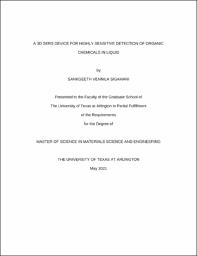
ATTENTION: The works hosted here are being migrated to a new repository that will consolidate resources, improve discoverability, and better show UTA's research impact on the global community. We will update authors as the migration progresses. Please see MavMatrix for more information.
Show simple item record
| dc.contributor.advisor | Hao, Yaowu | |
| dc.creator | Vennila Sigamani, Sankgeeth | |
| dc.date.accessioned | 2021-06-02T21:51:03Z | |
| dc.date.available | 2021-06-02T21:51:03Z | |
| dc.date.created | 2021-05 | |
| dc.date.issued | 2021-05-26 | |
| dc.date.submitted | May 2021 | |
| dc.identifier.uri | http://hdl.handle.net/10106/29855 | |
| dc.description.abstract | Detection of organic chemicals in liquid medium have been gaining utmost attention in recent times. Real time detection and monitoring of a variety of environmental pollutants, explosive materials, chemical agents, and pharmaceutical drugs in liquid medium are of great need in today’s technological advancements. While there are several scattering, emission and spectroscopy techniques in use, Raman spectroscopy is attractive because of its molecular specificity i.e., each molecule has a Raman fingerprint. Raman spectroscopy utilizes the inelastic portion of the scattered wave for detection. But since intensity of inelastic scattering (Raman scattering) is very low, compared to the elastic scattering, low concentration analysis has been challenging.
Surface-Enhanced Raman spectroscopy or Surface-Enhanced Raman Scattering (SERS) potentially overcomes this challenge, with its good detection capabilities for lower concentrations in liquid solution. SERS enhances the Raman signal of molecules (capable of 1010-fold enhancement) when they are adsorbed on a metal nanostructure (termed as SERS substrate) surface. The design of SERS substrate plays a crucial part in the enhancement of the Raman signal. Conventional 2D substrates are not very efficient in providing binding of the analyte molecules to SERS-sensitive hotspots and in-situ detection can be challenging, owing to the low volume of liquid on the surface. These challenges can be overcome by using three-dimensional (3D) hierarchical nanostructures as SERS substrates, because of its high hotspot density along all spatial directions.
Single crystal 3D silver dendrites are desirable for such application, due to the presence of nanotips and nanogaps which act as hotspots enhancing the Raman signal. These silver nano dendrites can be generated by a simple Galvanic Replacement Reaction (GRR) between copper wire and silver nitrate solution, yielding a multi-level branched nanostructure. These branched surfaces in proximity, have the capability to enhance the Raman signal of the analyte present, due to Localized Surface Plasmon Resonance effect (LSPR).
In this thesis, a reliable, reusable and low-cost SERS device, employing 3D silver nano dendrites, that can be used for in-situ monitoring of organic molecules in liquid flows is presented. This device has the capability to detect very low concentrations of organic chemicals, at parts per million range in liquid in real time, without much of an erroneous measurement and sample preparation. The device was made of 3D silver nano-dendrites enclosed in channels in PDMS. It is reusable, with good reproducibility and has the potential for multichannel configurations that can provide parallel analysis. This device is made reliable by calibrating using Rhodamine-6g, as a reference molecule. It can be then used to detect various Raman active molecules in liquid solution with varying concentrations.
We detected molecules of 4 Mercaptobenzoic Acid (4- MBA) and Methylene blue in liquid solutions with very low concentrations. Detection of Acetaminophen and Thiabendazole with good reproducibility, makes the device to have significant potentials at real-world applications in different fields. The device was successful in detecting ultra-low concentrations with high sensitivity, as compared to previously reported nano substrates thus making it a significant SERS substrate. | |
| dc.format.mimetype | application/pdf | |
| dc.language.iso | en_US | |
| dc.subject | Surface-enhanced raman scattering | |
| dc.subject | Ultrasensitive & in-situ detection | |
| dc.subject | Galvanic replacement reaction | |
| dc.subject | Silver dendrites as SERS substrate | |
| dc.subject | PDMS SERS device | |
| dc.title | A 3D SERS DEVICE FOR HIGHLY SENSITIVE DETECTION OF ORGANIC CHEMICALS IN LIQUID | |
| dc.type | Thesis | |
| dc.degree.department | Materials Science and Engineering | |
| dc.degree.name | Master of Science in Materials Science and Engineering | |
| dc.date.updated | 2021-06-02T21:51:04Z | |
| thesis.degree.department | Materials Science and Engineering | |
| thesis.degree.grantor | The University of Texas at Arlington | |
| thesis.degree.level | Masters | |
| thesis.degree.name | Master of Science in Materials Science and Engineering | |
| dc.type.material | text | |
Files in this item
- Name:
- VENNILASIGAMANI-THESIS-2021.pdf
- Size:
- 2.189Mb
- Format:
- PDF
This item appears in the following Collection(s)
Show simple item record


